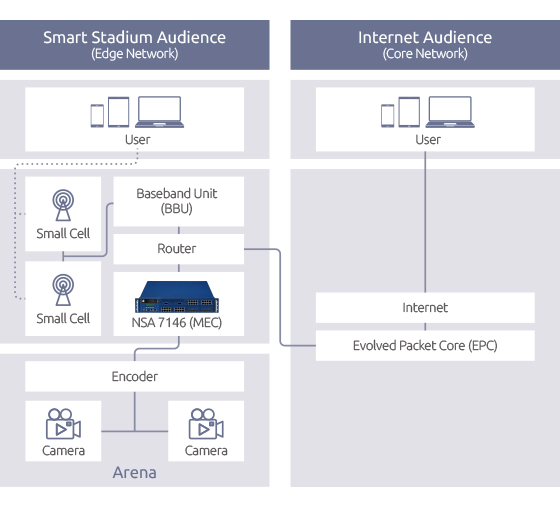New 5G Networks Are Fueling CDN Demand

Background
CDN, also known as content delivery network, is a cache mechanism that shares and loads content, usually video services, from a data center to users’ network edge. The worldwide popularity of the Internet has also resulted in the Internet carrying increasingly more services, especially the aforementioned video services. Users often watch Internet video content through platforms such as YouTube, STB, OTT, and smartphones. Traditionally, video content has been stored in a central data center, where global users flock to for video service requests. This creates massive data loads at the data center, as well as increased latency due to the distance between end users and the data center.
Viewer behavior patterns are often similar and occur at the same time, in the same area. For example, an area’s users may simultaneously watch a live baseball game. If the service provider places the game’s video content as close as possible to the area, this reduces transmission delay and loading from the data center. Only video content not provided by the local content server will be redirected to the data center.

This architecture is the so-called Content Delivery Network (CDN), which provides high quality video services and reduces latency and transmission. CDN is already quite popular in broadband, and the 5G mobile network will push CDNs to a new level of demand.
Challenge: 5G will create a burst of video streaming
According to Visual Networking Index’s forecast[1] of global Internet traffic, the proportion of smartphone usage will increase to 50% in 2022 from 23% in 2017, with 79% of mobile traffic in video format. Deployment of 5G infrastructure will result in greater bandwidth, which will also trigger greater demand of high quality video services.
However, video services on mobile networks are somewhat different from broadband networks. First, a variety of mobile devices in use means a variety in video resolution playback. Video service providers need to transcode video resolution to fit target mobile devices. Second, the quantity of mobile devices is enormous and geographically spread, so providers will need efficient methods to distribute videos. Finally, conventional mobile networks still employ data centers to provide video content. In order to fulfill video demands in a 5G world, the 5G network infrastructure needs a CDN architecture that’s able to provide high performance video transcoding and distribution with low latency.
Solution: vCDN provides video services with low latency
To meet these demands, NEXCOM launched NSA 7146. It’s a 2U rackmount network appliance based on the 2nd Generation Intel® Xeon® Scalable Processor family and delivers a workload-optimized platform for content delivery networks (CDNs). NSA 7146 has also been verified an “Intel® Select Solution for vCDN” through completing a list of CDN test sets and meeting certain criteria, including Ethernet packet processing speed benchmarks, video transcoding, and video distribution.
According to Heavy Reading’s survey[2] of CoSPs, 32% view CDN drivers in MEC (multi-access edge computing) use cases as extremely important and, arguably, the most important driver. Take the smart stadium audience as an example. Telecom companies provide “multi-angle mobile live broadcast” services, where stadium audiences can switch among the stadium cameras’ 4k live videos to watch the game from different angles, as opposed to the single view from their seats. When thousands of audience members simultaneously access this service, it creates massive data flow and 4k to 1080p video transcoding requests. It would be impractical to process video transcoding and distribution in a core network that’s far from the stadium but should rather be performed locally in order to provide services with low latency.

Figure 1. MEC use case for CDN.
In this use case, NSA 7146 can be an intermediary CDN platform. NSA 7146 has passed the “Intel® Select Solutions for vCDN” CDN test sets. To meet packet processing benchmarks, CDN platforms must demonstrate optimum performance with DPDK implementation. This requirement is applicable to vCDN deployments in existing NFVI environments where small packet forwarding performance plays an important role.
|
Test Items
|
Benchmark Config
|
Expected Values
|
NSA 7146 Test Result
|
|
Packet processing L3FWD
|
Zero Packet loss test
|
90 % Line rate with
Packet Size 256B |
Pass
|
|
RHEL KPI Tests
(25 Gbps NIC) |
PF Pass-through
(L3FWD in a VM) |
90 % Line rate with
Packet Size 256B |
Pass
|
|
SRIOV VF NIC
(L3FWD in a VM) |
90 % Line rate with
Packet Size 256B |
Pass
|
Table 1: Packet processing benchmarks.
The CDN service requests were performed in both HTTP and HTTPs formats. The platform capability to handle an expected number of requests per second is critical in IP CDN benchmark testing. We verified platform performance under different user quantities and request file sizes.
|
Test Items
|
Benchmark Config
|
Expected Values
|
NSA 7146 Test Result
|
|
http (in NVMe SSD)
with 3K users (File Size 1K) |
# of request per sec
|
90 % Line rate with
Packet Size 256B |
Pass, without error
|
|
Max CPU Utilization (%)
|
60 K
|
||
|
Max Interface Utilization (GB/s)
|
NA
|
||
|
Avg latency (ms)
|
0.181 ms
|
||
|
https (in NVMe SSD)
with 1K users (File Size 1K) |
# of request per sec
|
28 K
|
Pass, without error
|
|
Max CPU Utilization (%)
|
< 25 %
|
||
|
Max Interface Utilization (GB/s)
|
NA
|
||
|
Avg latency (ms)
|
0.07 ms
|
||
|
http (in NVMe SSD)
with 3K users (File Size 10K) |
# of request per sec
|
60 K
|
Pass, without error
|
|
Max CPU Utilization (%)
|
< 25 %
|
||
|
Max Interface Utilization (GB/s)
|
NA
|
||
|
Avg latency (ms
|
0.181 ms
|
||
|
https (in NVMe SSD)
with 1K users (File Size 10K) |
# of request per sec
|
28 K
|
Pass, without error
|
|
Max CPU Utilization (%)
|
< 25 %
|
||
|
Max Interface Utilization (GB/s)
|
NA
|
||
|
Avg latency (ms)
|
0.07 ms
|
Table 2: IP CDN benchmarks.

Figure 2. Architecture of IP CDN test.
Video transcoding is the key to CDN implementation. As mentioned in the smart stadium use case, a smartphone needs 4k resolution transcoded to 1080p in order to smoothly play back media. The CDN platform must have efficient capabilities to satisfy this transcoding need.
|
Test Items
|
Benchmark Config
|
Expected Values
|
NSA 7146 Test Result
|
|
H.264 1080p30 to
H.264 1080p30 transcoding, preset=medium |
# of Channels
|
10+10(20) streams
@ 1080p, 3+3(6) streams @ 4k |
Pass, without error
|
|
Max CPU Utilization (%)
|
1080p: 91%; 4k:83%
|
||
|
H.265 1080p30 to
H.265 1080p30 transcoding |
# of Channels
|
8+8(16) streams
@ 1080p, 3+3(6) streams @ 4k |
Pass, without error
|
|
Max CPU Utilization (%)
|
1080p: 89%; 4k:91%
|
Table 3: Video transcoding benchmarks.
Video distribution is the final step to a delivery service. When thousands of users make simultaneous requests, CDNs must be able to deliver video smoothly.
|
Test Items
|
Benchmark Config
|
Expected Values
|
NSA 7146 Test Result
|
|
HLS in SSD
(single video, multi user) |
# of Video streams
|
700 users per socket
|
Pass, without error
|
|
Max CPU Utilization (%)
|
~ 96 %
|
||
|
Throuthput (GB/s)
|
< 25 GB/s per interface
|
Table 4: Video streaming/distribution performance benchmarks.

Figure 3. Architecture of video distribution test.
|
Test Items
|
Specifications
|
|
Server Name
|
NSA 7146
|
|
Processor
|
2 x Intel® Xeon® Gold 6252 processors at 2.1 GHz
|
|
DRAM
|
12 x 32G DDR4 at 2666 MHz
|
|
Network Controllers
|
Intel® XXV710-AM2
|
|
Intel® QAT
|
C627
|
|
Intel® SATA SSDs
|
2* 480GB Intel® SSD SATA
|
|
Intel® 3D NAND SSDs
|
4* 2.0T Intel® P4510 NVMe
|
|
LAN on Motherboard
|
4 x 10G SFP+
|
|
Software
|
|
|
Operating System
|
RHEL Server 7.6
https://access.redhat.com/ecosystem/hardware/4182101 |
|
Caching Frameworks
|
NGINX*, Apache Traffic Server (ATS)
|
|
Media Libraries
|
FFmpeg, Media Service Studio*, Scalable Video Technology
|
Table 5: Detailed vCDN configuration and specifications.
Conclusion
In committing to being customers’ long-term supplier, NEXCOM focuses on powerful computing and network technology and helps customers build a superior infrastructure to face the rapid changes of a near-future 5G world.
The NSA 7146 is a CDN platform that provides high performance video transcoding and video distribution capacity. By deploying at the edge, it also delivers video services with low latency. The NSA 7146 should be your choice for building a content delivery network infrastructure to meet the challenges of a 5G environment.
References
[1] Cisco. (2019). Cisco visual networking index: forecast and trends, 2017–2022 [White paper]. Retrieved from https://www.cisco.com/c/en/us/solutions/collateral/service-provider/visual-networking-index-vni/white-paper-c11-741490.html
[2] Hodges, Jim. (n.d.) Transforming the edge: the rise of MEC [White paper]. Retrieved from https://www.intel.com/content/dam/www/public/us/en/documents/white-papers/the-rise-of-multi-access-edge-computing-paper.pdf

- Related Links:
- Bring Real-Time Efficiency to Every Warehouse Layer with NEXCOM Fast Time-Sensitive Networking Activation Kit
- Achieve Faster AI Insights with NEXCOM FTA 5190 and Xeon® 6 SoC
- Browse Other News:
- Urban PET Recycling Reinvented Sustainable Solutions Powered by NDiS B561
- AIEdge-X®80 Leaps Ahead: Power Up TOPS Performance with NVIDIA® Jetson™ Super Mode
- All White Papers News
